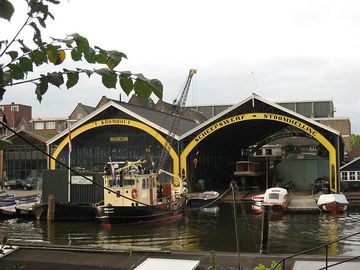

This is more of a collection of ship and boat engines rather than a museum. Among items on display are the famous diesel engines constructed by the Dutch firm Kromhout, once located here, and which were used for small ships and yachts a century long. The museum is sometimes referred to as the Machinekamer (the Engine Room), but its official full name is Museum Shipyard Kromhout, as its collection of engines is located side by side the presently active and working, if smaller in size and venture, Van Amerongen shipyard.
The Kromhout shipyards history began in 1757, when a wealthy lady from Amsterdam bought a plot of land located on one of the former marshes outside the city center, which have since been drained and converted into the present eastern islands, for her husband, a shipbuilder by the name of Doede Jansen Kromhout
The second half of the 19th century and the growing industrialization brought significant changes to the shipbuilding industry. The wooden sailing ships of yore were now made from steel, powered by steam engines and illuminated by electricity. At the end of the 1800s, Kromhout shipyards expanded, building hundreds of ships and manufacturing engines for these new ships. The small Kromhout 12HP engine became legendary for its uninterrupted working rhythm and its reliability. In the early decades of the 20th century, Kromhout grew further and even had shipyards across the Ij, in the northern part of Amsterdam.
Housed under two striking 19th-century wrought iron halls, named Westkap and Oosthal, this old-sailor engines collection smells of seaweed, oil and fuel. In 1967, the shipyard's operations were discontinued. In 1975, thanks to a grant by the Prince Bernhard Foundation, the wharf was saved from demolition. The Westkap is still actively in use as a shipyard. Every shipbuilding aficionado or a kid exhilarated by sea voyages will find this historical spot of Amsterdam maritime history fascinating.